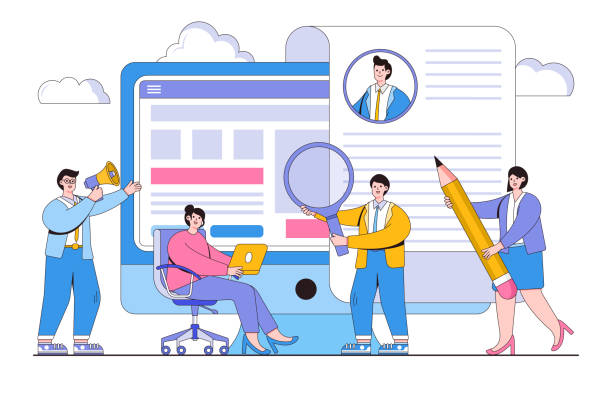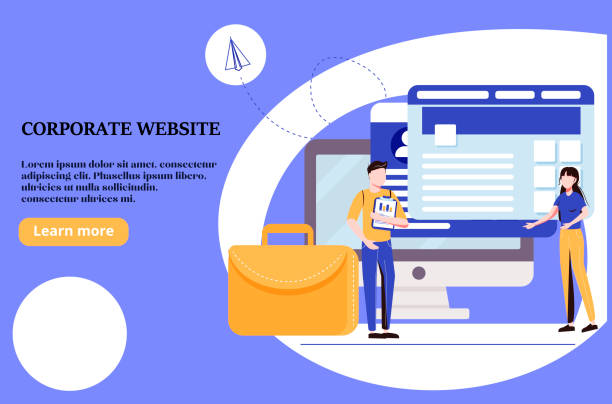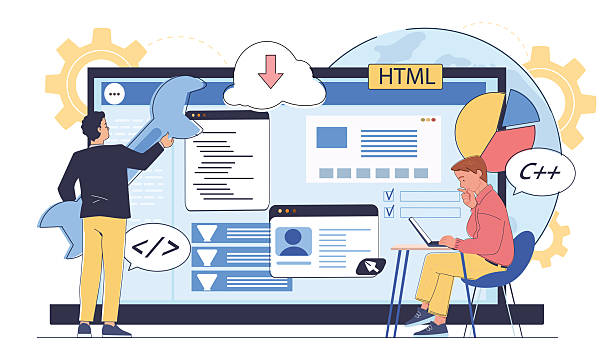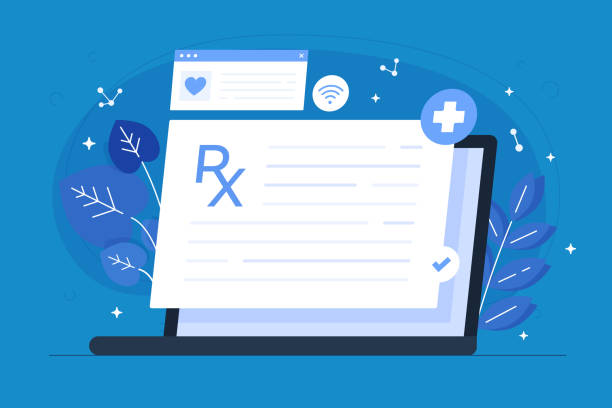Introduction to the Importance of Speed in Websites

In today’s digital world, website speed is not just a competitive advantage, but a vital necessity.
When it comes to #UserExperience and #SEO, nothing drives users away and lowers your search engine ranking like a slow website.
Fast website design means building a website that loads in the shortest possible time, even under poor network conditions.
This not only increases visitor satisfaction but also directly impacts your conversion rate and business success.
Studies have shown that every second of page load delay can lead to a significant decrease in page views and customer satisfaction.
This fact doubles the importance of investing in optimization and achieving a high-performance website.
Understanding the basic principles and components involved in website speed is the first step towards building a successful online platform.
Frustrated with your e-commerce site’s low conversion rate? Rasawab turns your e-commerce site into a powerful tool for attracting and converting customers!
✅ Significant increase in visitor-to-buyer conversion rate
✅ Unique user experience to increase customer satisfaction and loyalty⚡ Get free consultation from Rasawab!
Why Does Website Speed Play a Crucial Role?

The importance of website speed goes beyond mere user convenience and encompasses a wide range of aspects.
From an #SEO (Search Engine Optimization) perspective, search engines like Google consider page loading speed as an important ranking factor.
Slower websites rank lower in search results, which can mean losing significant organic traffic.
On the other hand, #UserExperience (UX) is heavily impacted by speed; today’s users rarely have the patience for slow websites and quickly leave the page.
This phenomenon, known as “Bounce Rate”, increases sharply on slow websites.
For online businesses, fast website design directly impacts conversion rates; every small delay can mean losing sales or registrations.
Ultimately, website speed is a reflection of a brand’s professionalism and credibility.
These aspects highlight the need for special attention to speed optimization and efforts towards high-performance website design.
Key Technical Factors Affecting Website Speed

A website’s speed is the result of a combination of several technical factors, each of which can significantly impact loading time.
Understanding these factors is crucial for anyone looking for fast website design.
The first factor is image size and optimization.
Large and unoptimized images can account for a significant portion of page load time.
Using modern formats like WebP and proper image compression is essential.
The second factor is CSS and JavaScript code.
Excess, unnecessary, or render-blocking code can delay page loading.
Minification and Concatenation of these files, along with Asynchronous loading, can significantly help.
The third factor is the quality and type of web hosting.
Low-quality hosting or distant servers significantly increase server response time (Time To First Byte – TTFB).
Choosing a reliable and high-quality hosting provider, with servers close to the target audience, is very important.
The fourth factor is the number of HTTP requests; each file (image, CSS, JS) creates a new HTTP request.
Reducing the number of requests by combining files or using techniques like CSS Sprites can be beneficial.
Finally, using heavy frameworks and libraries can also lead to a slow site.
Detailed analysis of each of these factors and bottleneck resolution paves the way for achieving an excellent performing website.
| Common Problem | Explanation | Optimization Solution |
|---|---|---|
| High-volume images | Unoptimized and large-dimension images. | Image compression, use of modern formats (WebP), Lazy Loading. |
| Render-blocking CSS/JS files | Scripts and styles stop page loading. | Minify, Concatenate, Asynchronous loading (Async/Defer). |
| Slow server response | Long time to receive the first byte from the server. | Hosting upgrade, database optimization, using CDN. |
| Too many HTTP requests | Loading too many separate files (image, script, style). | Combining files, using CSS Sprites, Inlining critical CSS/JS. |
Website Speed Measurement and Analysis Tools

To achieve a fast website design, we first need to assess the current situation and identify performance bottlenecks.
Fortunately, powerful tools are available for this purpose to help you conduct a precise analysis of your website’s speed.
The most important and widely used of these tools include:
- Google PageSpeed Insights: This free Google tool not only evaluates your page load speed on desktop and mobile but also provides suggestions for performance improvement.
These suggestions typically include image optimization, code compression, and caching. - GTmetrix: This tool provides more details than PageSpeed Insights, including a Waterfall chart showing the loading time of each page component.
It also displays YSlow and PageSpeed scores separately. - Lighthouse: An open-source and automated tool from Google designed to improve web page quality.
It evaluates important metrics such as performance, accessibility, best development practices, SEO, and PWA, and provides comprehensive reports.
Regularly using these tools and reviewing their reports allows you to identify #performance issues and implement appropriate solutions to increase your website’s speed.
This is a fundamental step on the path to optimization and achieving high performance.
Are you dissatisfied with the low visitor-to-customer conversion rate on your e-commerce site?
Solve this problem forever with professional e-commerce website design by Rasawab!
✅ Increase visitor-to-customer conversion rate
✅ Create an excellent user experience and build customer trust
⚡ Get free consultation
Client-Side (Front-End) Optimization for High Speed

A large part of fast website design involves client-side or front-end optimization.
This includes all files and codes that the user’s browser downloads and executes to display the page.
One of the most important techniques is Minification of CSS and JavaScript files.
This process involves removing extra characters like whitespace, comments, and newlines from the code, which reduces file size without changing functionality.
Also, Concatenation of files can reduce the number of HTTP requests, as the browser downloads one larger file instead of several smaller ones.
Another point is optimizing how CSS and JavaScript are loaded.
Using `async` and `defer` attributes for scripts can prevent page rendering from being blocked, meaning HTML can be displayed before scripts are fully loaded.
Also, placing CSS in the `
Optimizing web fonts, using responsive images, and lazy loading for images and videos that are not visible at the top of the page are other crucial front-end methods for achieving superior performance.
These actions help the user view page content as quickly as possible.
Server-Side (Back-End) and Database Optimization

Alongside front-end optimization, server-side and database optimization also plays a significant role in fast website design.
Server Response Time (TTFB) is one of the most important metrics affecting website speed.
To reduce TTFB, back-end code needs to be optimized and efficient.
This includes using optimized algorithms, reducing database queries, and preventing infinite loops.
Database optimization includes creating appropriate indexes for frequently used tables, cleaning up redundant records, and using efficient connections.
Using Content Management Systems (CMS) like WordPress or Joomla requires optimizing plugins and themes to prevent excessive server overhead.
Choosing a suitable web server like Nginx or Apache with optimal configuration, and using server-side caching can significantly reduce response time.
Additionally, Gzip compression on the server-side can reduce the volume of data sent before it reaches the user’s browser, which is particularly effective for text files like HTML, CSS, and JS.
Managing server resources, including CPU and RAM, and upgrading them if necessary, are important steps towards ensuring optimal performance and high speed.
The Role of CDN and Caching Strategies in Increasing Speed

To achieve a fast website design on a global scale, Content Delivery Networks (CDN) and caching strategies are of paramount importance.
A CDN is a system of geographically distributed servers that store your website’s static content (such as images, CSS, JS) and deliver it from the server closest to the user.
This reduces the physical distance of data and consequently decreases loading time.
In addition to CDN, caching is another key technique.
Caching allows browsers or servers to store local copies of content so that subsequent visits do not require re-loading from the origin server.
Types of caching include:
- Browser Caching: This type of cache allows the user’s browser to store static files (such as images, CSS, JS) so that subsequent visits do not require re-downloading.
This is done by setting HTTP headers like `Cache-Control` and `Expires`. - Server-side Caching: This type of caching occurs on the server-side and can include caching entire pages, database objects, or complex queries.
Using tools like Redis, Memcached, or CMS-specific caching systems can significantly improve performance. - CDN Caching: CDNs also have powerful caching mechanisms that store content at the edge of their network to deliver it to users at a higher speed.
By combining CDN and effective caching strategies, you can significantly reduce your website’s loading time and provide a better user experience.
| Caching Type | Storage Location | Main Benefit |
|---|---|---|
| Browser Caching | In user’s browser | Reduced repeated requests to the server, increased speed for subsequent visits. |
| Server-side Caching | On the website server | Reduced server processing load, increased response speed for all users. |
| CDN Caching | On CDN servers (edge network) | Content delivery from the closest geographical point, reduced network latency. |
Responsive Design and Speed on Mobile Devices

In the current era, where most users connect to the internet via mobile devices, the importance of fast website design on mobile platforms has become more apparent than ever.
Responsive Design means that your website automatically adjusts to the dimensions and resolution of the user’s device screen.
However, merely being responsive is not enough; mobile speed requires special attention due to various reasons, including lower bandwidth and more limited processing power of devices.
Using responsive images that load screen-size-appropriate versions using `srcset` and `sizes` attributes in HTML is one of the fundamental solutions.
Also, implementing AMP (Accelerated Mobile Pages) for news pages or articles that are primarily text-based can significantly increase loading speed.
Optimizing CSS and JavaScript files so that only the codes required for mobile display are loaded, and removing unnecessary resources, is also vital.
Content prioritization (Critical CSS), meaning faster loading of important and visible parts of the page (Above the Fold), can significantly improve the user’s initial experience.
Also, paying attention to Touch Targets and Minimum Tap Area for interactive elements improves the user experience on mobile.
In summary, mobile design should start with a focus on speed and efficiency from the ground up.
Are you losing business opportunities due to an outdated website? With Rasawab, solve the problem of not attracting potential customers through your website forever!
✅ Attract more high-quality leads
✅ Increase brand credibility in customers’ eyes
⚡ Get free corporate website design consultation
Continuous Monitoring and Maintenance for Speed Preservation

Achieving fast website design is not a one-time process, but a continuous effort.
After implementing initial optimizations, it is necessary to continuously monitor your website’s speed and perform the necessary maintenance actions.
Web performance monitoring tools (APM) like New Relic, Datadog, or Pingdom can help you track website performance in real-time and receive necessary alerts if any speed drop occurs.
Setting a “Performance Budget” is also an effective approach; this means defining the maximum allowable size for files, number of HTTP requests, and page load time.
This ensures that developers are forced to adhere to these limitations during the development process and prevents the addition of heavy code or unnecessary resources.
Regularly updating the Content Management System (CMS), plugins, and themes is also essential for maintaining security and performance, as new versions often include performance optimizations and bug fixes.
Also, regularly checking for broken links, missing images, and browser console errors can help maintain the website’s health and speed.
This proactive approach ensures that your website always operates with high speed and efficiency.
Future Trends in Web Performance Optimization

The web world is constantly evolving, and with it, performance optimization techniques and technologies also advance.
Understanding future trends in fast website design is essential for developers and website owners to design their platforms with a forward-looking approach.
One of the most important current trends is Google’s Core Web Vitals.
These three metrics (Largest Contentful Paint, First Input Delay, Cumulative Layout Shift) have become key indicators for evaluating user experience and are expected to play a more prominent role in SEO rankings in the future.
New network protocols like HTTP/3, built on QUIC, promise faster and more reliable communication between browser and server, and will significantly impact loading speed by reducing latency and improving connection management.
The wider use of Artificial Intelligence (AI) in performance optimization is also emerging; from intelligent image compression to predicting user behavior for pre-loading resources.
Also, focusing on Serverless Web experiences and microservices architectures can lead to greater scalability and flexibility, and ultimately to faster website design.
These developments indicate that the path of web optimization is endless and requires continuous learning and adaptation to ensure that websites always remain at their peak performance.
Frequently Asked Questions
| Question | Answer |
|---|---|
| What is fast website design? | The process of building websites that load quickly. |
| Why is website speed important? | It improves user experience, positively impacts SEO, and increases conversion rates. |
| What factors affect website loading speed? | Server speed, image size, code optimization, browser caching. |
| How can website speed be increased? | Image optimization, compressing CSS and JavaScript files, using a CDN, and choosing suitable hosting. |
| What are common tools for testing website speed? | Google PageSpeed Insights, GTmetrix, Pingdom Tools. |
| Does server geographical location affect speed? | Yes, a shorter distance between the user and the server leads to lower latency and higher speed. |
| What does image optimization mean? | Reducing the file size of images without significantly reducing their quality. |
| What is browser caching and how does it help speed? | Temporary storage of website resources (like images, CSS, and JS files) in the user’s browser for faster loading on subsequent visits. |
| What is the impact of website speed on SEO? | Google considers website speed as a ranking factor; faster sites usually achieve a better ranking. |
| How can CSS and JavaScript files be optimized? | By Minification and Concatenation of files to reduce size and number of requests. |
And other services of Rasawab Advertising Agency in the field of advertising
Smart SEO: Professional optimization for online growth using key page optimization.
Smart Reportage: Professional optimization for increasing click-through rates using real data.
Smart UI/UX: Designed for businesses looking to analyze customer behavior through key page optimization.
Smart Customer Journey Map: A combination of creativity and technology to increase sales through custom programming.
Smart UI/UX: Professional optimization for user interaction using user experience customization.
And more than hundreds of other services in the field of internet advertising, advertising consultation, and organizational solutions
Internet Advertising | Advertising Strategy | Advertorial
Resources
How to increase website speed?
Website performance optimization tips
Fast website design guide
Best practices for improving website performance
? To reach the pinnacle of success in the digital world, Rasawab Afarin Digital Marketing Agency introduces your business to a wider audience by offering innovative solutions in multilingual website design and SEO optimization. Shine professionally with us!
📍 Tehran, Mirdamad Street, next to Bank Markazi, Kazeroun Jonoubi Alley, Ramin Alley No. 6




